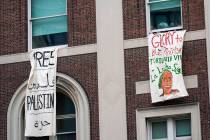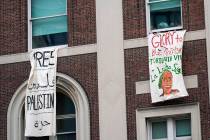Redistricting promises to keep identity politics alive
This week the state expects to begin receiving population data from the Census Bureau that will facilitate the redrawing of political districts in Nevada -- everything from city council wards to congressional and school board districts.
The process promises to be difficult and divisive, pitting party against party, ethnic group against ethnic group. Each will be vying to increase its clout at the political table.
News stories have begun to hint at the coming scuffle.
Hispanics already hold two state Senate seats and six Assembly seats, but activists hope to redraw district lines in such a way as to increase their influence by another Senate seat and two more Assembly seats. Some are asking whether an Asian district might be crafted.
Then there is the probability the state will get a fourth congressional district, which will surely engender a whole new round of horse trading, as it did 10 years ago, when the state was awarded a third seat in the House of Representatives.
It doesn't have to be that way. Any high school kid could redistrict the state by adding up the populations of precincts starting in Laughlin and heading north one at time. When you arrive at a quarter of the state's population you have a congressional district. Then start on the next.
Do the same with state Senate seats, counting precincts until you have 1/21st of the state population. The same for 42 Assembly seats. The same for county commission, city council and school district seats.
Not so fast, Mitchell, you say? The courts have interpreted the Voting Rights Act of 1965 to prohibit the diluting of minority voting strength.
Let us revisit history as outlined by Abigail Thernstrom in "Redistricting, Race, and the Voting Rights Act."
After the Civil War, the 15th Amendment prohibited denial of voting rights "on account of race, color, or previous condition of servitude." This worked fairly well until federal troops pulled out in 1877 and the white supremacists started coming up with poll taxes, literacy tests and assorted means of intimidation and outright violence.
The Voting Rights Acts was intended to remedy the problem of the appallingly low percentage of blacks registered to vote. But it had unintended consequences.
"Racial gerrymandering also contributes to the larger problem of polarization," Thernstrom writes. "By concentrating black voters in safe black constituencies, it tends to 'bleach' adjoining districts. In the more conservative South, those whiter surrounding districts tend to be safely Republican while black districts are safely Democratic. In this and other ways, the Voting Rights Act has had important partisan as well as racial consequences."
The question may be: Has the Voting Rights Act accomplished its goals and now outlived its usefulness?
Nevada has an Hispanic governor. The nation has a black president. This is not strictly a recent phenomenon. Back in 2002, of seven blacks in the state Legislature, all were from districts with populations less than a third black. One was from a district only 2 percent black.
If you are going to draw majority-minority districts, you have to have enclaves of ethnicity or heritage. A Review-Journal story this past week revealed Las Vegas is one of the least segregated metropolitan areas in the country. It is 99th out of 100 in segregation of blacks and whites and 100th for segregation of Asians and whites. For Hispanic segregation, the community ranked 65th.
The courts are beginning to balk at what some justices have called race balkanization.
U.S. Supreme Court Justice Sandra Day O'Connor warned back in 1993, "Racial gerrymandering, even for remedial purposes, may balkanize us into competing racial factions; it threatens to carry us further from the goal of a political system in which race no longer matters."
Justice Clarence Thomas wrote a year later, "If one surveys the history of the Voting Rights Act one can only be struck by the sea change that has occurred in the application and enforcement of the Act since it was passed in 1965. The statute was originally perceived as a remedial provision directed specifically at eradicating discriminatory practices that restricted blacks' ability to register and vote in the segregated South. Now, the Act has grown into something entirely different. In construing the Act to cover claims of vote dilution, we have converted the Act into a device for regulating, rationing, and apportioning political power among racial and ethnic groups."
Perhaps, just perhaps, this is now the time for Nevadans to apportion voters according to their proximity instead of their ethnicity. Something along the lines of judging people by the quality of their character instead of the color of their skin and their party affiliation.
After all, each of us is a minority of one.
Thomas Mitchell is senior opinion editor of the Review-Journal. He may be contacted at 383-0261 or via e-mail at tmitchell@ reviewjournal.com. Read his blog at lvrj.com/blogs/mitchell.























